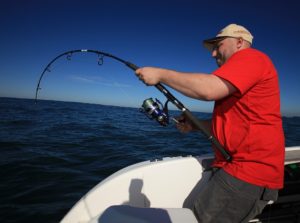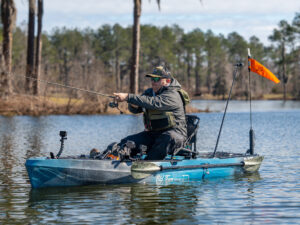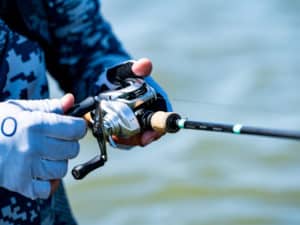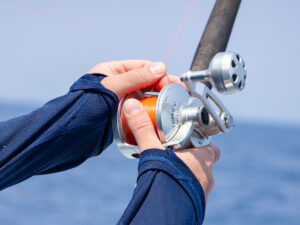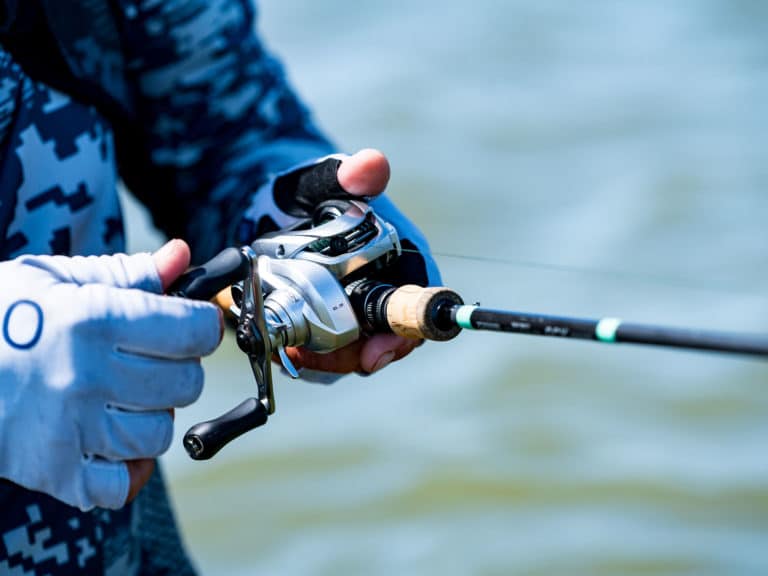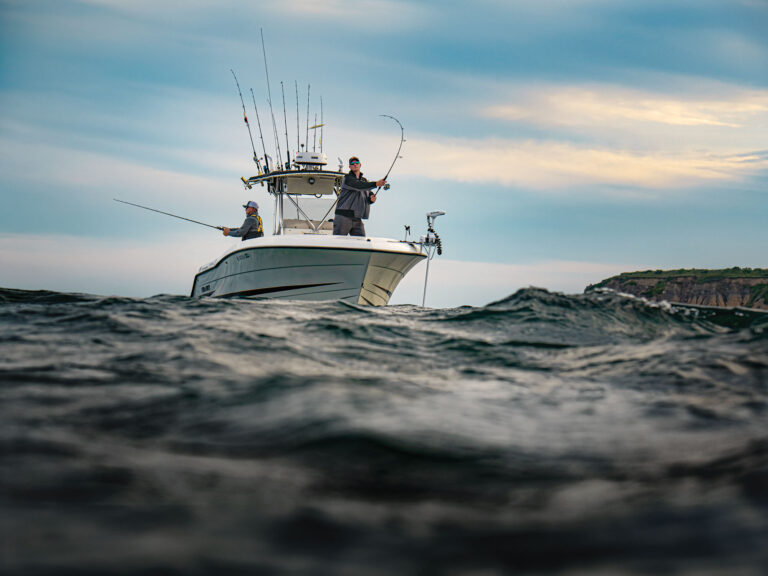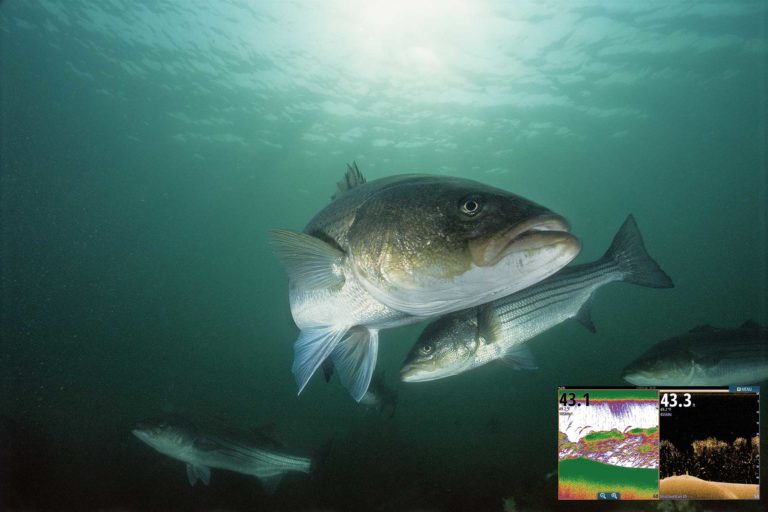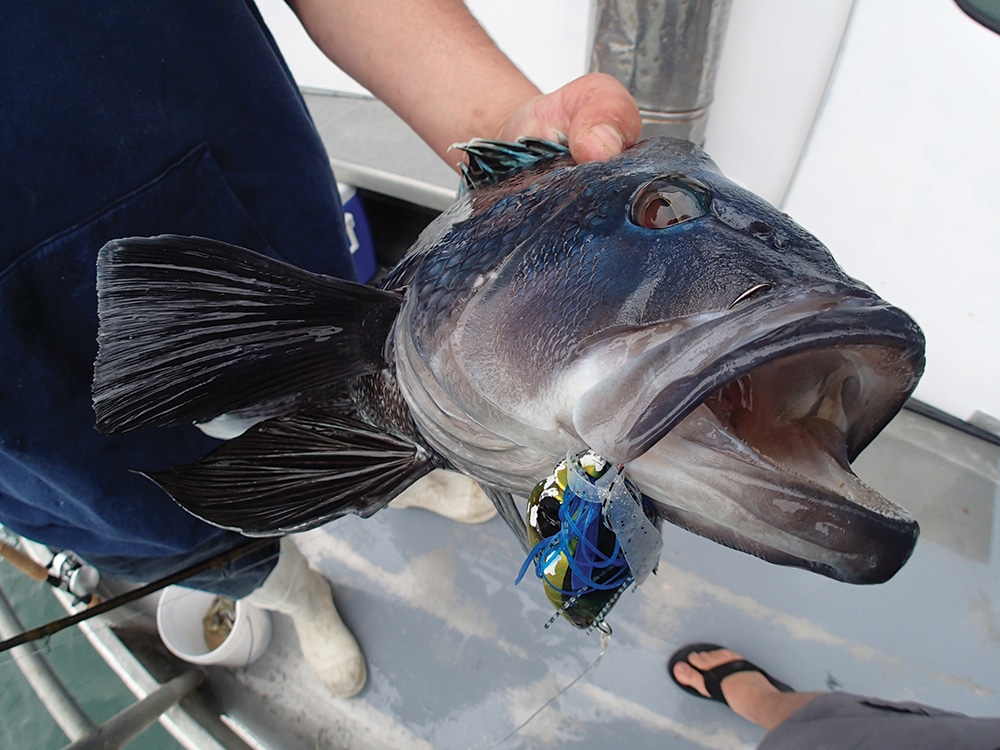
Put down your jigging rod. Rest your aching arm. It’s time to consider fishing with slow jigs. The bean-shaped heads with wavy tentacles from manufacturers like Shimano, C&H Lures and Braid Products catch a variety of species without making you pump your arms into a cramp.
But why try these odd jigs when traditional metals are so successful?
“You don’t have to work them fast because of their design and action,” says Steve Grant, general manager of C&H Lures. “Offshore, sometimes you want to relax a bit. Drop the jig all the way to the bottom, and then make five or six cranks. If there’s no bite, drop the jig again. It’s great for getting those bottomfish.”
The list of species that bite these types of jigs is expansive. On the West Coast, yellowtail, white seabass, lingcod and rockfish all take the squid-looking metals. In the Atlantic and Gulf of Mexico, black sea bass, weakfish, fluke, amberjack, tilefish, snapper and grouper are liable to attack.
C&H Lures’ 2-ounce Alien jig is also a cobia killer on the East Coast, says Grant, who’s based out of Jacksonville, Florida. He should know: The north Florida port is widely recognized as a top destination for cobia each summer.
Deliberate Design
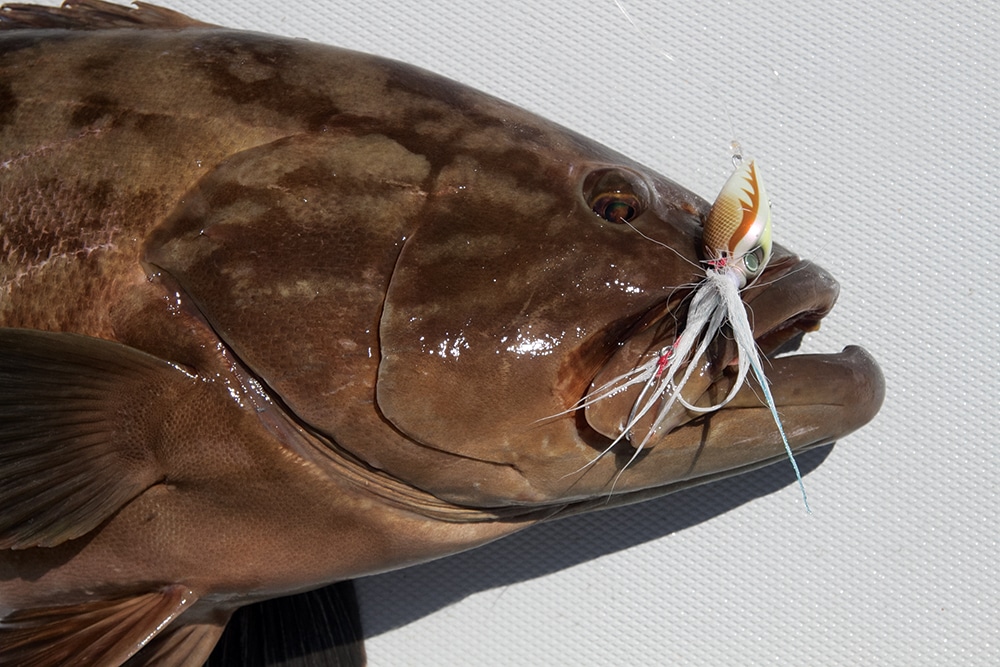
One of the first questions that has to be asked is, where did the crazy colors and designs originate?
“The styles came over from Japanese commercial fishermen,” says Doug Rusch, a Shimano sales representative in Asbury, New Jersey. “The small hooks on jigs like the Shimano Lucanus were designed for highly pressured species. Sea bass chew on the tentacles of the baits, slowly making their way up the bait — those small hooks are never detected.”
Jigs like the Lucanus, Braid’s Sea Fox and Thumper Squid, Salt Life’s Big Eye Salty, Warbaits Warblade, and Toro Tamer’s Soft Tako all have unique features. But there are definite similarities with each of these slow baits. Each has a heavy head and some sort of skirted body, and many are rigged with a pair of trailing J-hooks. The Warbaits Warblade might be the exception — it incorporates a willow blade and a weed guard.
The color schemes all seem to mimic the Hypercolor T-shirts of the late ’80s that changed color in the sun. The wacky colors and skirts likely mimic squid or octopus. After all, the two cephalopods startle predators by changing colors with their special pigment cells.
“I definitely think the jigs imitate squid in our area,” says Grant. “Even if they don’t, it doesn’t matter, because the fish eat them!”
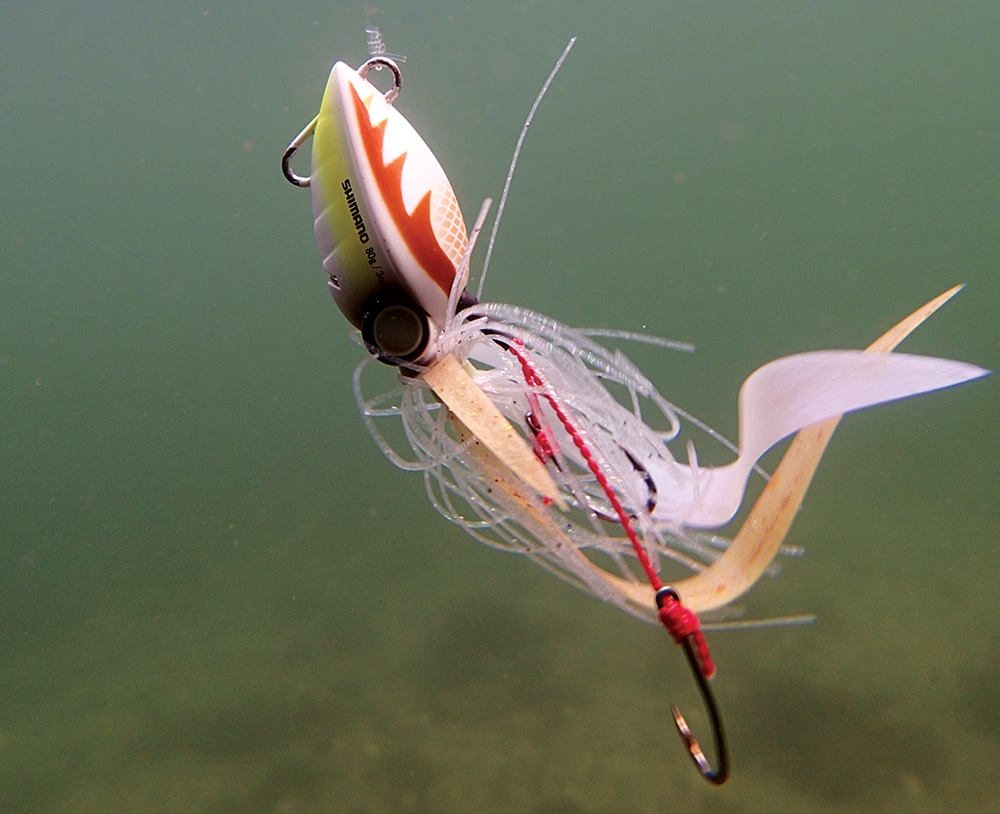
Rusch thinks it might be something else, at least for the black sea bass that he catches.
“After harvesting sea bass and looking in their stomach,” says Rusch, “I noticed lots of crabs. The colorful jigs imitate the calico crabs that are orange-spotted, and brown-and-orange jigs imitate the darker crabs.”
Heavy Load
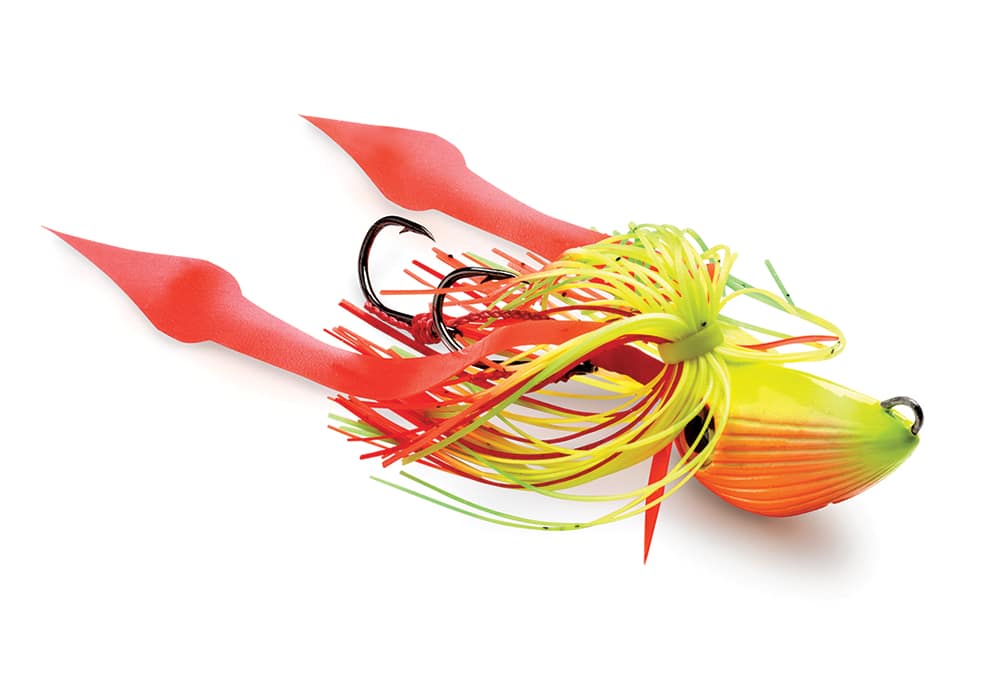
To use the jigs properly, Rusch recommends soft-action conventional or spinning gear in the 30- to 40-pound range. Shimano’s Tescata rods were designed specifically for the Lucanus jigs and are made with high-modulus graphite for a crisp feel. A 6-foot, 6-inch medium-light rod handles 2- to 3-ounce jigs; a 6-foot, 3-inch medium-heavy rod handles 7-ounce jigs.
“I’ll pair my rods with Curado 300 baitcasters, 30-pound braided line and 20- to 30-pound leader,” says Rusch. “Of course, current and depth factor into how light of tackle I’ll use.”
Grant has a basic approach in deciding how heavy a jig to fish.
“I’ll fish a 4-ounce jig for sea bass and snapper in 65 to 120 feet of water,” says Grant. Grant bumps up to a 6-ounce jig in 150 to 200 feet of water, and 8 ounces in waters deeper than 200 feet.
C&H Lures also markets the new Salt Life brand of jigs. In 2014, anglers can expect to see heftier weights for its Salty Blade and Big Eye Salty jigs. In 2013, Salt Life offered the Big Eye Salty in just 2 ounces.
Slow jigs have proved effective in both warm water and cooler water.
“Most anglers bounce the lures on the bottom, though yellowtail often take them on the drop,” says Mark Smith, of Toro Tamer lures in Huntington Beach, California. “Typical depths fished with these lures ranges from 25 to 100 feet.”
No matter which slow jig you intend to use, a sensitive rod is key to detecting the sometimes-subtle bite.
“Don’t ‘swing’ on the bite; continue to reel as you would using a circle hook,” says Rusch. “The shape of the head allows you to fish in some heavy structure too. With the shape of the weight and smaller hooks, you can unsnag your bait. That’s something you can’t do with a bucktail with its eye set farther back.”
Customize Your Creation
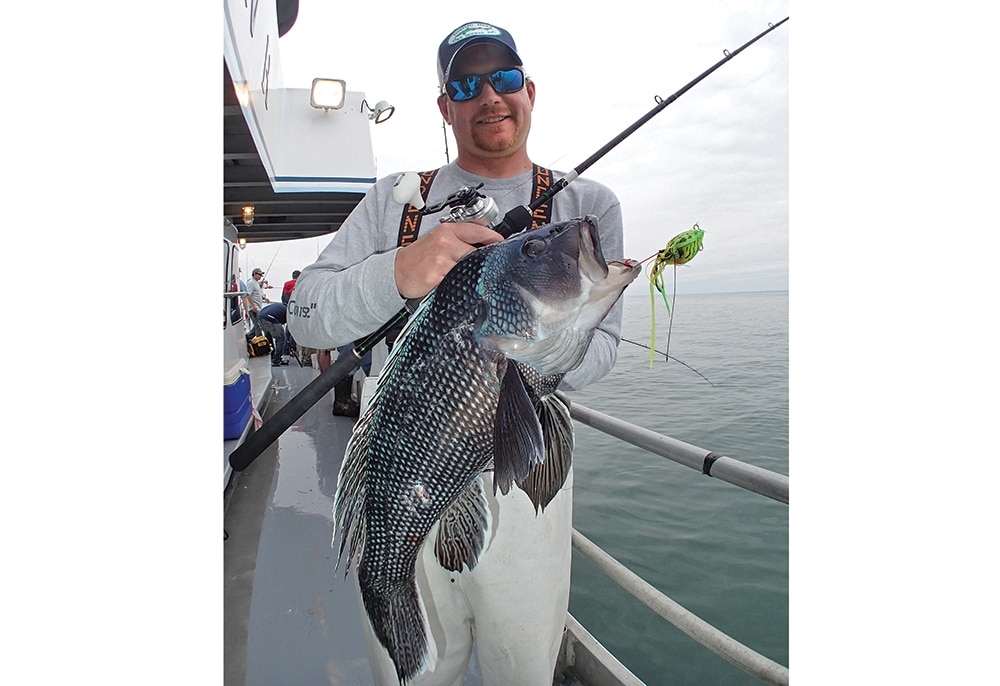
Replacement hooks and skirts are often available for these pricey, versatile jigs at each company’s website. Some anglers take it a step further, customizing jigs right out of the box.
“Our Soft Tako — modeled after an octopus — is rigged with both a fixed single and floating treble hook, and that’s been fine for most applications,” says Smith. “But we’ve also had clients experiment with rerigging using wired single hooks and assist-style hooks. For larger game fish, that’s not a bad call, since these lures were originally intended for bass and shallow-water rockfish.”
Some jigs like the Shimano Lucanus jigs have a secondary eye that allows anglers to add another hook, or a piece of leader section attached to an extra sinker or even a second jig.
“The larger, more-aggressive fish tend to be the first to attack,” says Rusch. But at some point, those smaller hooks end up catching smaller fish. We all recognize that it’s hard to release fish pulled from deep water, so that’s when upsizing the hook size is a solid choice.
“It’s all about trial and error,” says Grant, “You do get a better hookup ratio with the smaller hooks hiding inside the skirt. But some anglers will upsize the hook and add a strip of bait or squid.”
Anyone who’s ordered squid, octopus or crab at a seaside restaurant knows they can be darn tasty, points out Smith. So it’s no surprise the number of species that munch these lures is lengthy. Relax, grab that sensitive‑tipped rod, and reel tight.

